TOYOTA C-HR 2020 Owners Manual (in English)
Manufacturer: TOYOTA, Model Year: 2020, Model line: C-HR, Model: TOYOTA C-HR 2020Pages: 536, PDF Size: 11.99 MB
Page 1 of 536
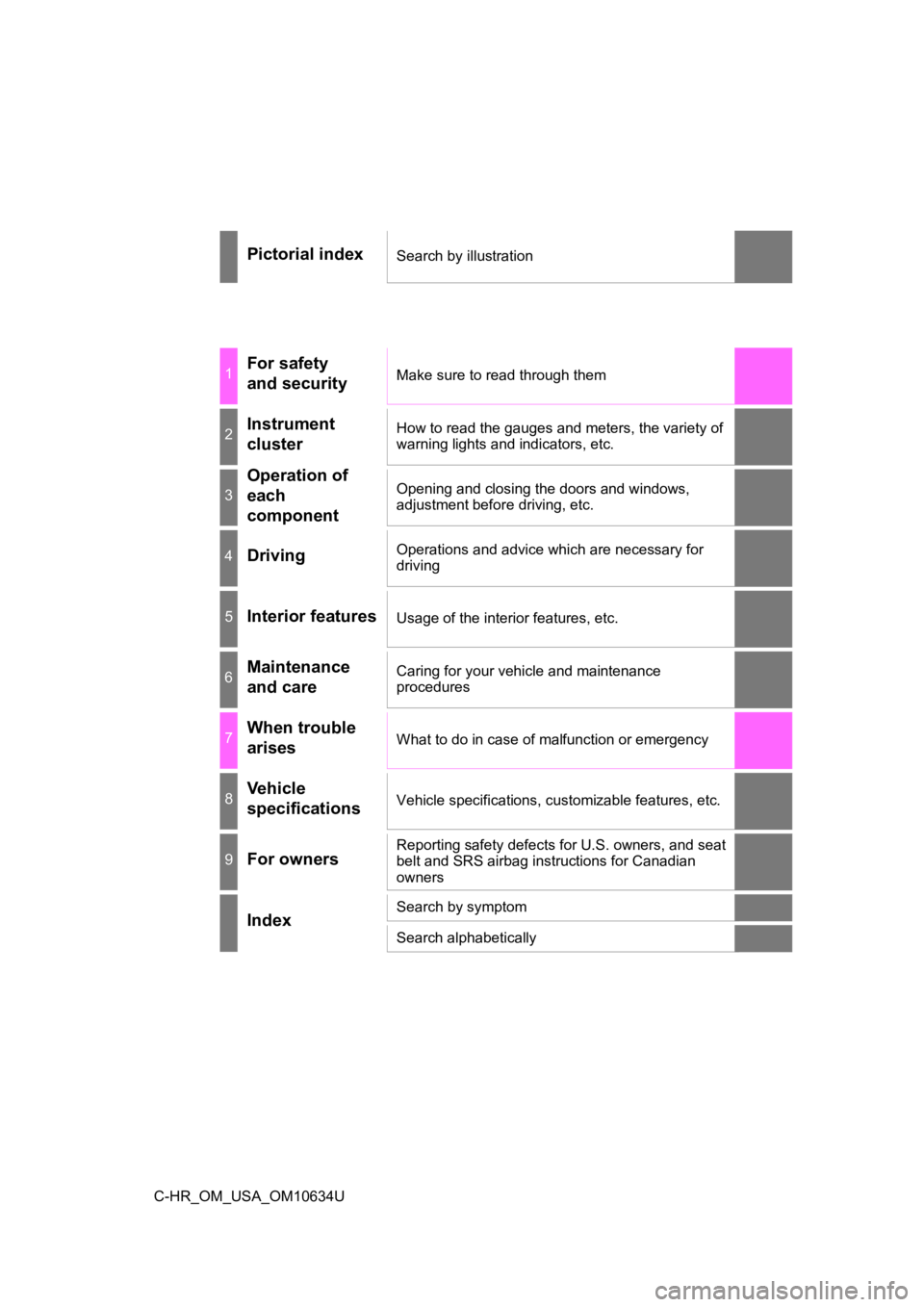
C-HR_OM_USA_OM10634U
Pictorial indexSearch by illustration
1For safety
and securityMake sure to read through them
2Instrument
clusterHow to read the gauges and meters, the variety of
warning lights and indicators, etc.
3
Operation of
each
componentOpening and closing the doors and windows,
adjustment before driving, etc.
4DrivingOperations and advice which are necessary for
driving
5Interior featuresUsage of the interior features, etc.
6Maintenance
and careCaring for your vehicle and maintenance
procedures
7When trouble
arisesWhat to do in case of malfunction or emergency
8Vehicle
specificationsVehicle specifications, customizable features, etc.
9For ownersReporting safety defects for U.S. owners, and seat
belt and SRS airbag instructions for Canadian
owners
IndexSearch by symptom
Search alphabetically
Page 2 of 536
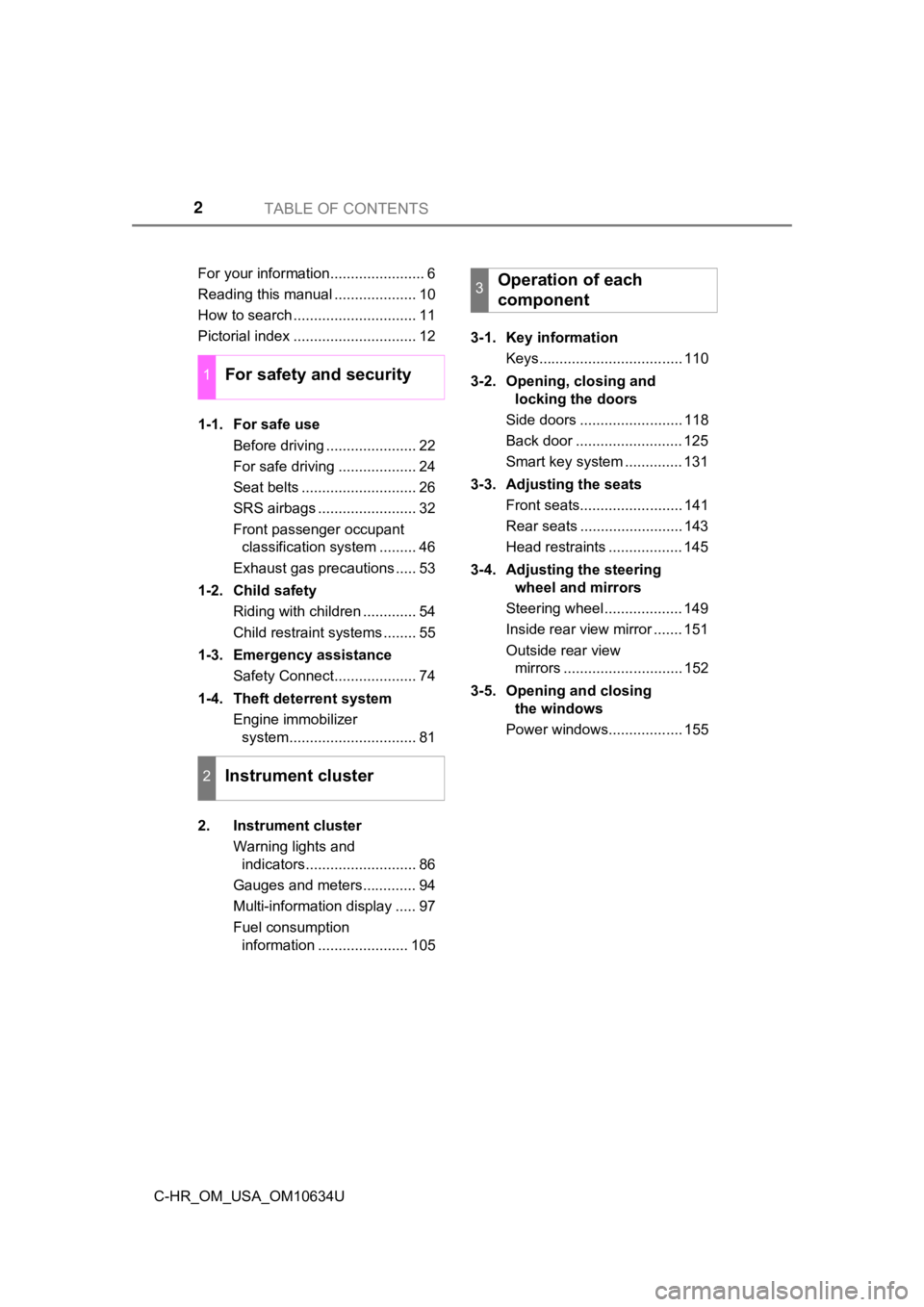
TABLE OF CONTENTS2
C-HR_OM_USA_OM10634UFor your information....................... 6
Reading this manual .................... 10
How to search .............................. 11
Pictorial index .............................. 12
1-1. For safe use
Before driving ...................... 22
For safe driving ................... 24
Seat belts ............................ 26
SRS airbags ........................ 32
Front passenger occupant classification system ......... 46
Exhaust gas precautions ..... 53
1-2. Child safety Riding with children ............. 54
Child restraint systems ........ 55
1-3. Emergency assistance Safety Connect.................... 74
1-4. Theft deterrent system Engine immobilizer system............................... 81
2. Instrument cluster Warning lights and indicators........................... 86
Gauges and meters............. 94
Multi-information display ..... 97
Fuel consumption information ...................... 105 3-1. Key information
Keys................................... 110
3-2. Opening, closing and locking the doors
Side doors ......................... 118
Back door .......................... 125
Smart key system .............. 131
3-3. Adjusting the seats Front seats......................... 141
Rear seats ......................... 143
Head restraints .................. 145
3-4. Adjusting the steering wheel and mirrors
Steering wheel ................... 149
Inside rear view mirror ....... 151
Outside rear view mirrors ............................. 152
3-5. Opening and closing the windows
Power windows.................. 155
1For safety and security
2Instrument cluster
3Operation of each
component
Page 3 of 536
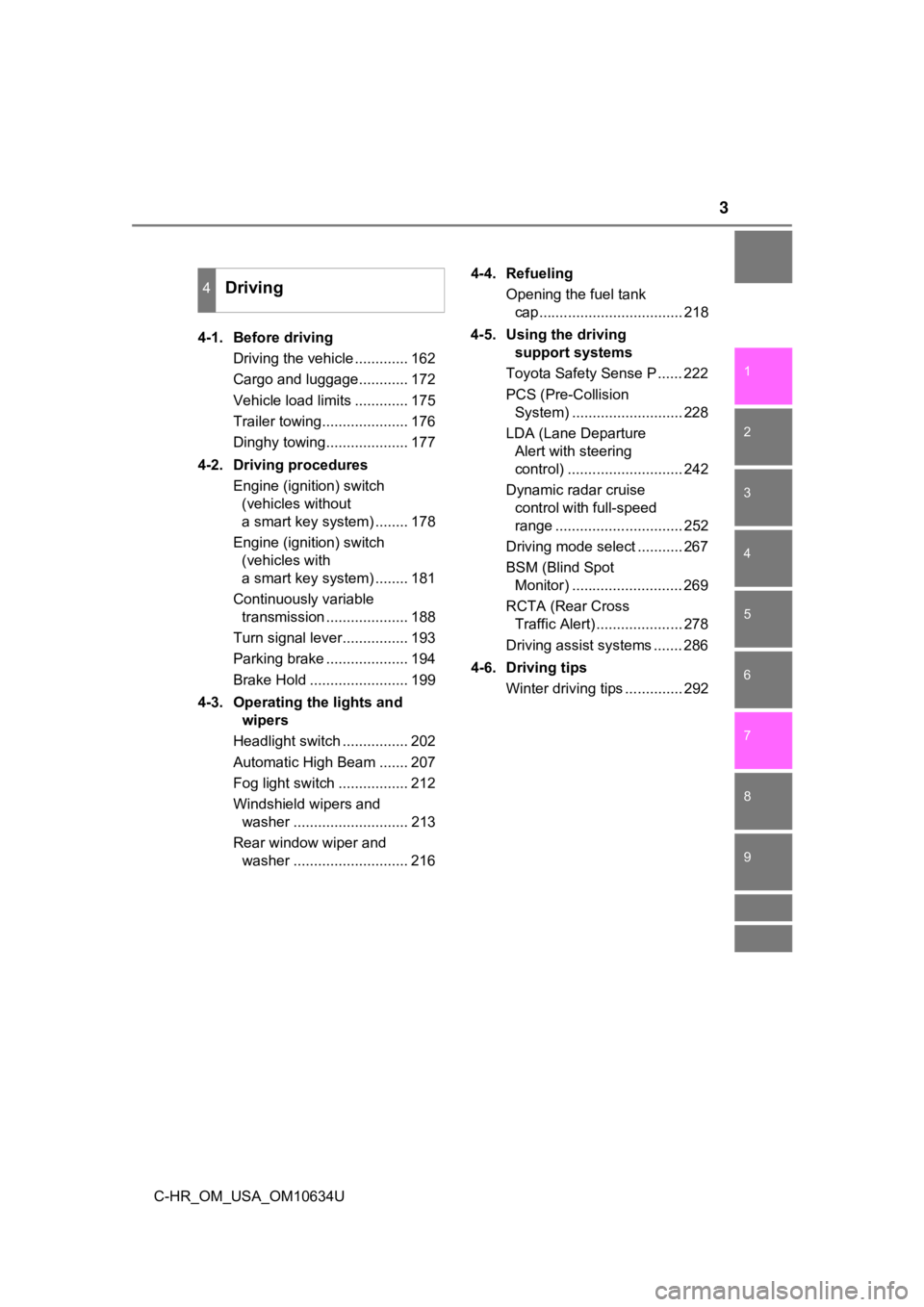
3
1
8 7 5 4
3
2
9
C-HR_OM_USA_OM10634U
6
4-1. Before drivingDriving the vehicle ............. 162
Cargo and luggage............ 172
Vehicle load limits ............. 175
Trailer towing..................... 176
Dinghy towing.................... 177
4-2. Driving procedures Engine (ignition) switch (vehicles without
a smart key system) ........ 178
Engine (ignition) switch (vehicles with
a smart key system) ........ 181
Continuously variable transmission .................... 188
Turn signal lever................ 193
Parking brake .................... 194
Brake Hold ........................ 199
4-3. Operating the lights and wipers
Headlight switch ................ 202
Automatic High Beam ....... 207
Fog light switch ................. 212
Windshield wipers and washer ............................ 213
Rear window wiper and washer ............................ 216 4-4. Refueling
Opening the fuel tank cap................................... 218
4-5. Using the driving support systems
Toyota Safety Sense P ...... 222
PCS (Pre-Collision System) ........................... 228
LDA (Lane Departure Alert with steering
control) ............................ 242
Dynamic radar cruise control with full-speed
range ............................... 252
Driving mode select ........... 267
BSM (Blind Spot Monitor) ........................... 269
RCTA (Rear Cross Traffic Alert) ..................... 278
Driving assist systems ....... 286
4-6. Driving tips Winter driving tips .............. 292
4Driving
Page 4 of 536

TABLE OF CONTENTS4
C-HR_OM_USA_OM10634U5-1. Using the air conditioning
system and defogger
Air conditioning system ..... 298
Heated steering wheel/ seat heaters .................... 306
5-2. Using the interior lights Interior lights list ................ 308• Interior lights ................. 309
• Personal lights .............. 310
5-3. Using the storage features
List of storage features...... 311 • Glove box...................... 312
• Console box .................. 312
• Bottle holders ................ 313
• Cup holders .................. 314
Luggage compartment features ........................... 315
5-4. Using the other interior features
Other interior features ....... 321 • Sun visors ..................... 321
• Vanity mirrors................ 321
• Power outlet .................. 322
• Assist grips ................... 323 6-1. Maintenance and care
Cleaning and protecting the vehicle exterior .......... 326
Cleaning and protecting the vehicle interior ........... 330
6-2. Maintenance Maintenance requirements ................... 333
General maintenance ........ 336
Emission inspection and maintenance (I/M)
programs ......................... 340
6-3. Do-it-yourself maintenance Do-it-yourself service precautions ...................... 341
Hood .................................. 344
Positioning a floor jack....... 346
Engine compartment ......... 347
Tires................................... 362
Tire inflation pressure ........ 372
Wheels............................... 376
Air conditioning filter .......... 379
Wireless remote control/electronic key
battery ............................. 383
Checking and replacing fuses ................................ 387
Headlight aim (vehicles with front fog lights) ......... 391
Light bulbs ......................... 393
5Interior features6Maintenance and care
Page 5 of 536
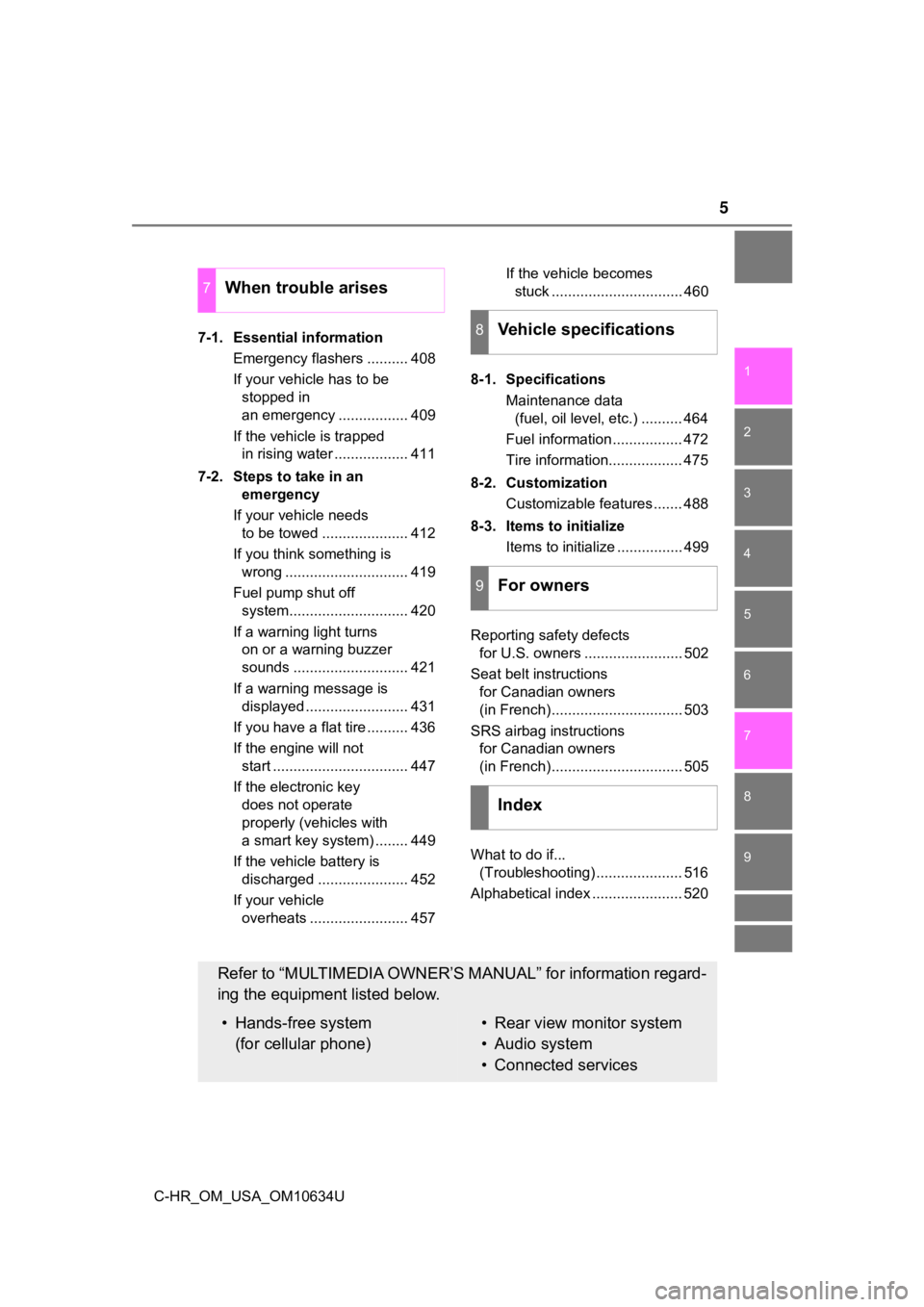
5
1
8 7 5 4
3
2
9
C-HR_OM_USA_OM10634U
6
7-1. Essential informationEmergency flashers .......... 408
If your vehicle has to be stopped in
an emergency ................. 409
If the vehicle is trapped in rising water .................. 411
7-2. Steps to take in an emergency
If your vehicle needs to be towed ..................... 412
If you think something is wrong .............................. 419
Fuel pump shut off system............................. 420
If a warning light turns on or a warning buzzer
sounds ............................ 421
If a warning message is displayed ......................... 431
If you have a flat tire .......... 436
If the engine will not start ................................. 447
If the electronic key does not operate
properly (vehicles with
a smart key system) ........ 449
If the vehicle battery is discharged ...................... 452
If your vehicle overheats ........................ 457 If the vehicle becomes
stuck ................................ 460
8-1. Specifications Maintenance data (fuel, oil level, etc.) .......... 464
Fuel information ................. 472
Tire information.................. 475
8-2. Customization Customizable features ....... 488
8-3. Items to initialize Items to initialize ................ 499
Reporting safety defects for U.S. owners ........................ 502
Seat belt instructions for Canadian owners
(in French)................................ 503
SRS airbag instructions for Canadian owners
(in French)................................ 505
What to do if... (Troubleshooting) ..................... 516
Alphabetical index ...................... 520
7When trouble arises
8Vehicle specifications
9For owners
Index
Refer to “MULTIMEDIA OWNER’S MANUAL” for information regard-
ing the equipment listed below.
• Hands-free system (for cellular phone)• Rear view monitor system
• Audio system
• Connected services
Page 6 of 536
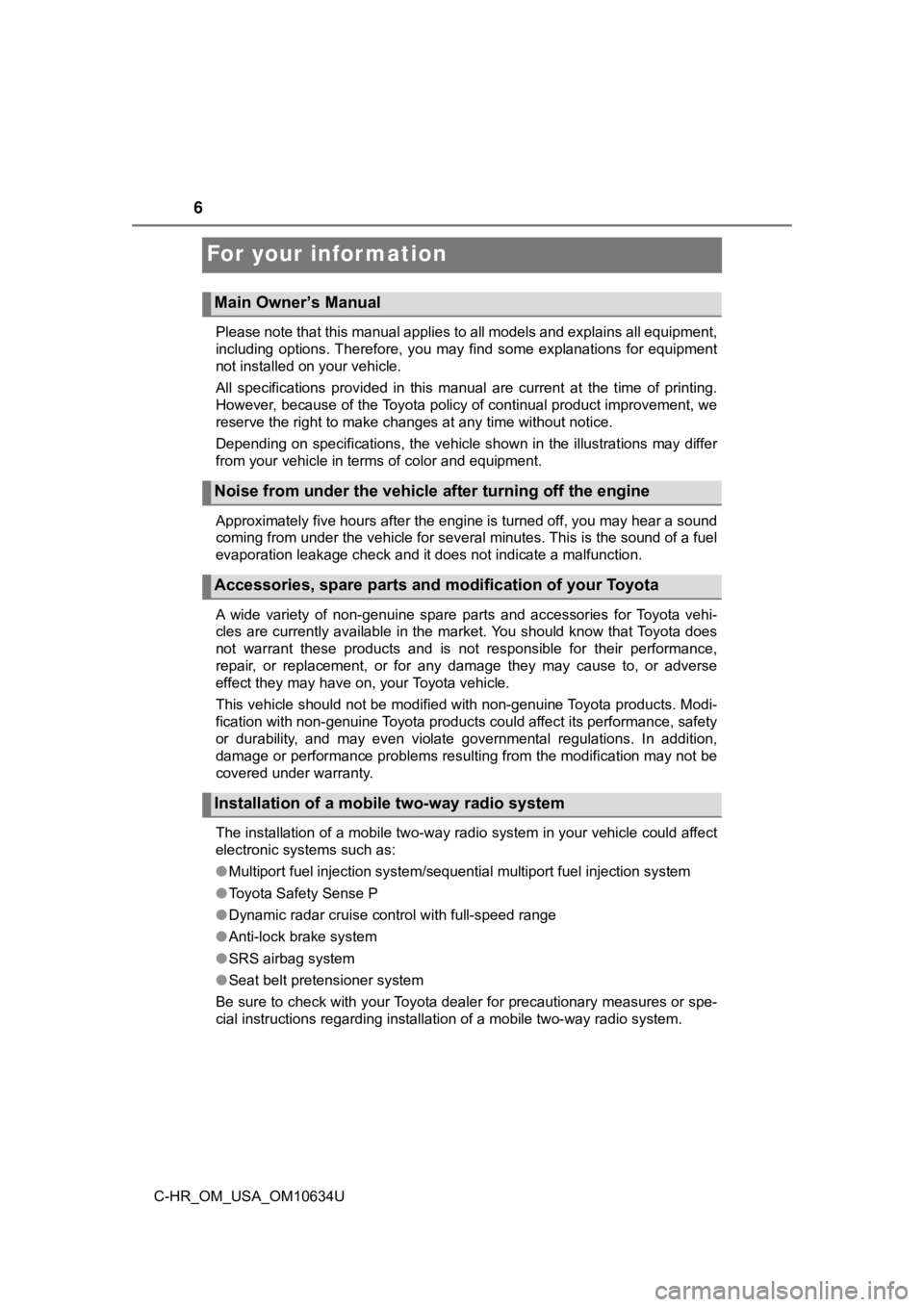
6
C-HR_OM_USA_OM10634U
For your infor mation
Please note that this manual applies to all models and explains all equipment,
including options. Therefore, you may find some explanations fo r equipment
not installed on your vehicle.
All specifications provided in this manual are current at the t ime of printing.
However, because of the Toyota policy of continual product impr ovement, we
reserve the right to make changes at any time without notice.
Depending on specifications, the vehicle shown in the illustrat ions may differ
from your vehicle in terms of color and equipment.
Approximately five hours after the engine is turned off, you ma y hear a sound
coming from under the vehicle for several minutes. This is the sound of a fuel
evaporation leakage check and it does not indicate a malfunctio n.
A wide variety of non-genuine spare parts and accessories for T oyota vehi-
cles are currently available in the market. You should know tha t Toyota does
not warrant these products and is not responsible for their per formance,
repair, or replacement, or for any damage they may cause to, or adverse
effect they may have on, your Toyota vehicle.
This vehicle should not be modified with non-genuine Toyota pro ducts. Modi-
fication with non-genuine Toyota products could affect its perf ormance, safety
or durability, and may even violate governmental regulations. In addition,
damage or performance problems resulting from the modification may not be
covered under warranty.
The installation of a mobile two-way radio system in your vehic le could affect
electronic systems such as:
● Multiport fuel injection system/sequential multiport fuel injection system
● Toyota Safety Sense P
● Dynamic radar cruise control with full-speed range
● Anti-lock brake system
● SRS airbag system
● Seat belt pretensioner system
Be sure to check with your Toyota dealer for precautionary meas ures or spe-
cial instructions regarding instal lation of a mobile two-way radio system.
Main Owner’s Manual
Noise from under the vehicle a fter turning off the engine
Accessories, spare parts and m odification of your Toyota
Installation of a mobile two-way radio system
Page 7 of 536

7
C-HR_OM_USA_OM10634UThe vehicle is equipped with sophisticated computers that will
record certain
data, such as:
The recorded data varies according to the vehicle grade level and options
with which it is equipped. These computers do not record conver sations or
sounds, and only record images outside of the vehicle in certai n situations.
• Engine speed / Electric motor speed (traction motor speed)
• Accelerator status
• Brake status
• Vehicle speed
• Operation status of the driving assist systems, such as the AB S and pre-
collision system
• Images from the front camera (available only when certain safe ty sys-
tems are activated, which varies depending on the vehicle specifica-
tions).
●Data Transmission
Your vehicle may transmit the data recorded in this computer to Toyota
without notification to you.
●Data usage
Toyota may use the data recorded in these computers to diagnose malfunc-
tions, conduct research and development, and improve quality.
Toyota will not disclose the recorded data to a third party exc ept:
• With the consent of the vehicle owner or with the consent of the lessee if the vehicle is leased
• In response to an official request by the police, a court of l aw or a govern-
ment agency
• For use by Toyota in a lawsuit
• For research purposes where the data is not tied to a specific vehicle or
vehicle owner
●Recorded image information can be erased by your Toyota dealer.
The image recording function can be disabled. However, if the f unction is
disabled, data from when the pre-collision system operates will not be
available.
●To learn more about the vehicle data collected, used and shared by
Toyota, please visit www.toyota.com/privacyvts/.
Usage of data collected through Safety Connect (U.S. mainland only)
If your Toyota has Safety Connect and if you have subscribed to those ser-
vices, please refer to the Safety Connect Telematics Subscript ion Service
Agreement for information on data collected and its usage.
●To learn more about the vehicle data collected, used and shared by
Toyota, please visit www.toyota.com/privacyvts/.
Vehicle data recording
Page 8 of 536

8
C-HR_OM_USA_OM10634UThis vehicle is equipped with an event data recorder (EDR). The
main pur-
pose of an EDR is to record, in certain crash or near crash-lik e situations,
such as an air bag deployment or hitting a road obstacle, data that will assist
in understanding how a vehicle’s systems performed. The EDR is designed to
record data related to vehicle dynamics and safety systems for a short period
of time, typically 30 seconds or less.
The EDR in this vehicle is designed to record such data as:
• How various systems in your vehicle were operating;
• Whether or not the driver and passenger safety belts were buckled/fas-tened;
• How far (if at all) the driver was depressing the accelerator and/or brake pedal; and,
• How fast the vehicle was traveling.
These data can help provide a better understanding of the circu mstances in
which crashes and injuries occur.
NOTE: EDR data are recorded by your vehicle only if a non-trivi al crash situ-
ation occurs; no data are recorded by the EDR under normal driv ing condi-
tions and no personal data (e.g., name, gender, age, and crash location) are
recorded. However, other parties, such as law enforcement, could combine
the EDR data with the type of personally identifying data routi nely acquired
during a crash investigation.
To read data recorded by an EDR, special equipment is required, and access
to the vehicle or the EDR is needed. In addition to the vehicle manufacturer,
other parties, such as law enforcement, that have the special e quipment, can
read the information if they have access to the vehicle or the EDR.
●Disclosure of the EDR data
Toyota will not disclose the data recorded in an EDR to a third party except
when:
• An agreement from the vehicle’s owner (or the lessee for a lea sed vehi-
cle) is obtained
• In response to an official request by the police, a court of l aw or a govern-
ment agency
• For use by Toyota in a lawsuit
However, if necessary, Toyota may:
• Use the data for research on vehicle safety performance
• Disclose the data to a third party for research purposes witho ut disclosing
information about the specific vehicle or vehicle owner
Event data recorder
Page 9 of 536
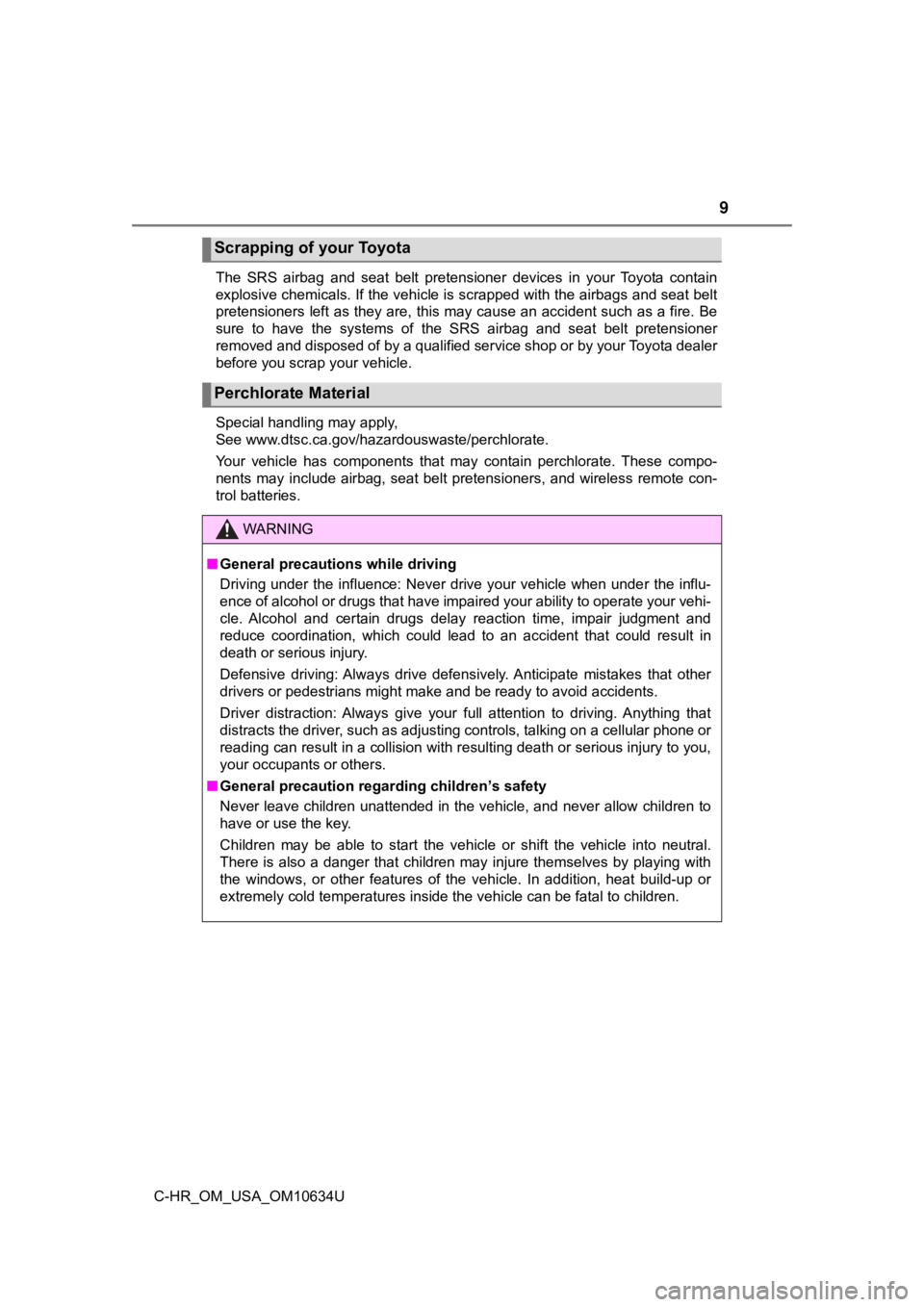
9
C-HR_OM_USA_OM10634UThe SRS airbag and seat belt pretensioner devices in your Toyot
a contain
explosive chemicals. If the vehicle is scrapped with the airbag s and seat belt
pretensioners left as they are, this may cause an accident such as a fire. Be
sure to have the systems of the SRS airbag and seat belt preten sioner
removed and disposed of by a qualified service shop or by your Toyota dealer
before you scrap your vehicle.
Special handling may apply,
See www.dtsc.ca.gov/hazardouswaste/perchlorate.
Your vehicle has components that may contain perchlorate. These compo-
nents may include airbag, seat belt pretensioners, and wireless remote con-
trol batteries.
Scrapping of your Toyota
Perchlorate Material
WARNING
■ General precautions while driving
Driving under the influence: Never drive your vehicle when unde r the influ-
ence of alcohol or drugs that have impaired your ability to operate your vehi-
cle. Alcohol and certain drugs delay reaction time, impair judg ment and
reduce coordination, which could lead to an accident that could result in
death or serious injury.
Defensive driving: Always drive defensively. Anticipate mistake s that other
drivers or pedestrians might make and be ready to avoid acciden ts.
Driver distraction: Always give your full attention to driving. Anything that
distracts the driver, such as adjusting controls, talking on a cellular phone or
reading can result in a collision with resulting death or serio us injury to you,
your occupants or others.
■ General precaution regar ding children’s safety
Never leave children unattended in the vehicle, and never allow children to
have or use the key.
Children may be able to start the vehicle or shift the vehicle into neutral.
There is also a danger that children may injure themselves by p laying with
the windows, or other features of the vehicle. In addition, hea t build-up or
extremely cold temperatures inside the vehicle can be fatal to children.
Page 10 of 536
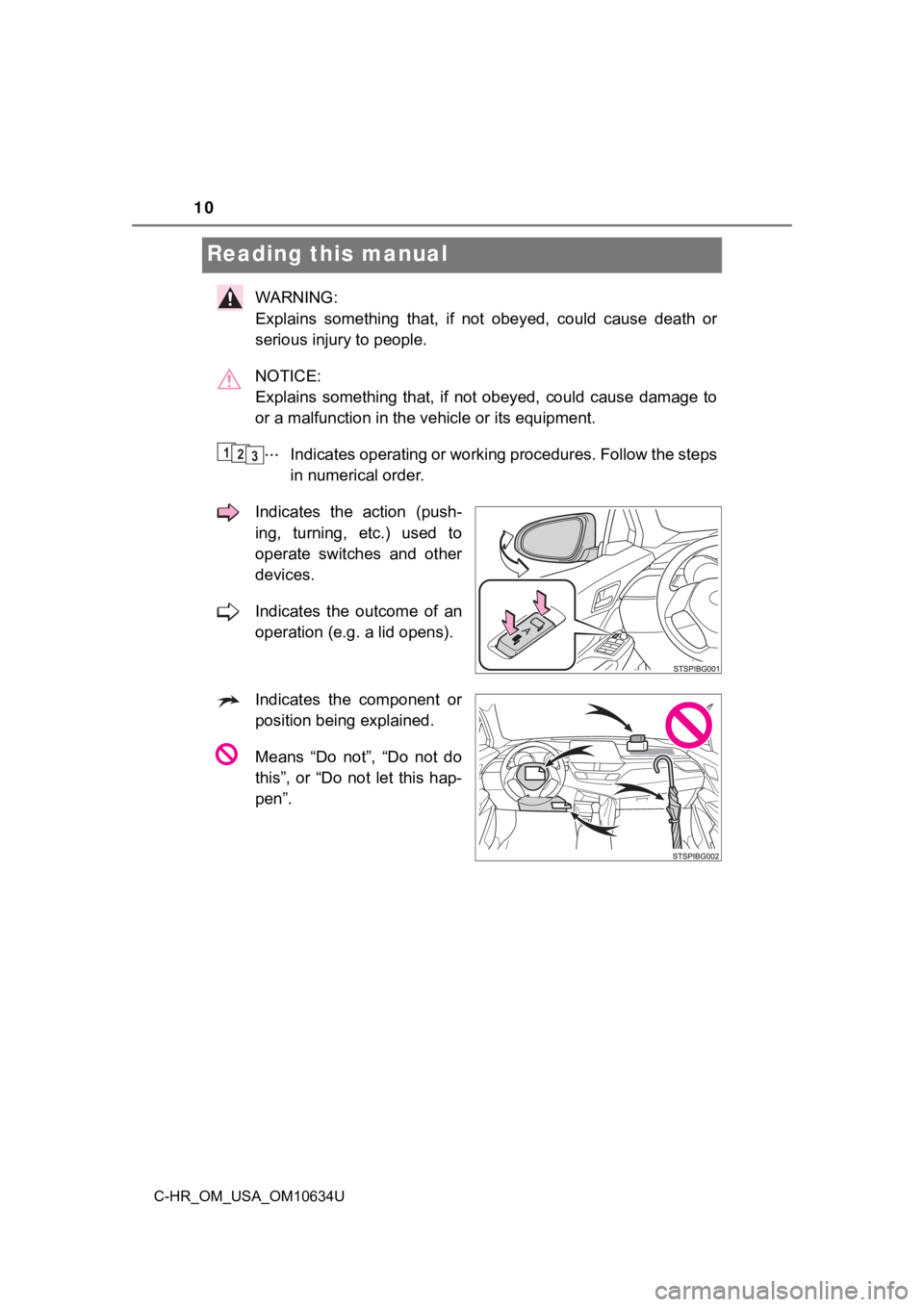
10
C-HR_OM_USA_OM10634U
Reading this manual
WARNING:
Explains something that, if not obeyed, could cause death or
serious injury to people.
NOTICE:
Explains something that, if not obeyed, could cause damage to
or a malfunction in the vehicle or its equipment.
Indicates operating or working procedures. Follow the steps
in numerical order.
Indicates the action (push-
ing, turning, etc.) used to
operate switches and other
devices.
Indicates the outcome of an
operation (e.g. a lid opens).
Indicates the component or
position being explained.
Means “Do not”, “Do not do
this”, or “Do not let this hap-
pen”.
123